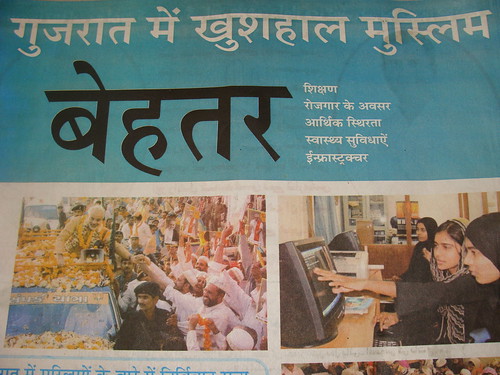By TwoCircles.net Staff Reporter,
Ahmedabad: Chief Minister Narendra Modi recently inserted full-page ad in major Patna dailies to show Muslims in Gujarat were very well off and educationally ahead of Hindus. He quoted in the ad excerpts from Sachar Committee Report to prove his point. So, will Modi tell what has happened to Muslims in his state in the last 8 years since the Godhra train carnage of February 2002? And what is the actual present condition of the community there?
Will Modi explain why Gujarat is the only state in the country without a minority commission? Why hasn’t the state government implemented the student scholarship programme for minority students floated by the central government since 2005? He won’t. But it is open for all to see. Muslims in the state are discriminated by banks on one hand, their areas are bypassed by development on the other. Besides, the overall educational condition of the community is very poor.

Gujarat govt. ad published in Patna dailies on 10 June 2010
Banks discriminate with Muslims
Will Modi explain why the Muslims share in advances provided by private and public sector banks in the state was just 1.5 per cent against their share of 10 per cent in the population of the state?
According to State Level Bankers Committee report on advances for 2006-07, out of a total of Rs. 80,000 crores advanced by various banks during 2006-07 in the state, Muslims share was a little above Rs. 1,000 crore, indicating inadequate share of Muslims in trade and business in the state. The report explains the widespread poverty and overall low economic status of the community and blasts Modi’s claims.
Development bypasses Muslim areas
In fact, the situation on the ground is totally different from the claims made by Modi. If one visits Gujarat, he/she will find there are two Gujarats: one provided with all basic civic amenities and infrastructure and the other resembling like a slum with not even safe drinking water. The first one is inhabited by mostly Hindus and the other one generally by Muslims. And one can confirm by seeing cities like Ahmedabad, Vadodara and Godhra, the epicenter of 2002 anti-Muslim carnage in the state.
Muslim areas are without banking, health and education facilities. They lack civic infrastructure like proper roads, drinking water supply and electrification. Ahmedabad’s Juhapura, the biggest Muslim pocket with a population over three lakh, did not have a bank branch till a year ago. There is no health or education facility available from the government side here. All the roads and lanes in Juhapura turn into virtual waterpools during monsoon in the absence of proper road and drainage facilities. There is also no safe drinking water supply here.
In contrast, areas like Vejalpur and Jivraj Park adjoining Juhapura that had begun developing simultaneously with Juhapura some 30 years ago enjoy all the basic amenities and are counted among the city’s posh areas.
Almost a similar situation is there in Tandalja, a new Muslim pocket that developed in the last 15 years in Vadodara. While the areas like J P Road and Gotri around it are among the top posh areas of Vadodara with civic infrastructure provided by the government, Tandalja remains neglected.
The condition of western part of Godhra, inhabited by Muslims, is the worst. While the eastern part of Godhra with school, colleges, hospitals and government offices has made it develop fast, the western part with no such facilities presents a picture of utter backwardness. After 2002 riots, the state electricity department disconnected the Western Godhra from the town’s common power supply system and created a separate power supply grid for it, enabling the powermen to stop power supply to Muslim areas at their whims and fancies.
Modi government also failed to rehabilitate victims of 2002 riots. Most of the rehabilitation has been done by the NGOs and social service organizations, with state government in many cases putting obstructions.
Educational status of Muslims
Similarly, Narendra Modi’s claim in Patna dailies ad of high literacy rate of Muslims in Gujarat is based on twisted facts.
The statistics about educational status of Gujarati Muslims are quite twisted and lopsided. There are three Muslim communities-Bohras, Khojas and Memon-whose living standard is comparable to the most advanced communities of the state. And educationally, Bohras and Khojas-both Shias- are so advanced that it is difficult to find even a single non-gradudate among them. And being business communities, they have produced richest Muslims not only in India but in the world like Azim premji of Wipro and Habeel Khorakiwala of Wockhardt. As far as Memons, belonging to Sunni sect, are concerned, they are educationally a little behind Bohras and Khojas but economically their position compares well with not only Bohras and Khojas but also with wealthy Hindus.
However, these three Muslim communities account for a fraction of Muslim population in the state and there is a vast gap between them and the rest of Muslims as far as education and financial status is concerned.
But when the figures of these communities are clubbed with the rest of Muslims who are extremely backward in terms of education and financial status, the average figure goes up, making their per capita income and literacy rate above average figures of Hindus in the state as given in the Sachar Committee Report based on 2001 census. Similarly, per capita income and literacy level of Hindus after being clubbed with tribals, the most backward educationally and financially, goes down than Gujarat Muslims.
Given the real sad picture of the Muslim community in Gujarat, it was no wonder if Narendra Modi used in newspaper advertisement a photo of Azamgarh Muslim girls learning computer in Shibli College of the eastern Uttar Pradesh district. The ad claimed Muslims are shining in Gujarat.

